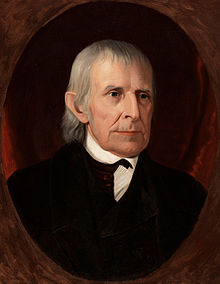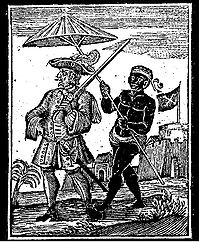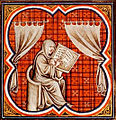Portal:Biography
The Biography Portal
A biography, or simply bio, is a detailed description of a person's life. It involves more than just basic facts like education, work, relationships, and death; it portrays a person's experience of these life events. Unlike a profile or curriculum vitae (résumé), a biography presents a subject's life story, highlighting various aspects of their life, including intimate details of experience, and may include an analysis of the subject's personality.
Biographical works are usually non-fiction, but fiction can also be used to portray a person's life. One in-depth form of biographical coverage is called legacy writing. Works in diverse media, from literature to film, form the genre known as biography.
An authorized biography is written with the permission, cooperation, and at times, participation of a subject or a subject's heirs. An autobiography is written by the person themselves, sometimes with the assistance of a collaborator or ghostwriter. (Full article...)
Featured biographies –
Edward Drinker Cope (July 28, 1840 – April 12, 1897) was an American zoologist, paleontologist, comparative anatomist, herpetologist, and ichthyologist. Born to a wealthy Quaker family, he distinguished himself as a child prodigy interested in science, publishing his first scientific paper at the age of 19. Though his father tried to raise Cope as a gentleman farmer, he eventually acquiesced to his son's scientific aspirations.
Cope had little formal scientific training, and he eschewed a teaching position for field work. He made regular trips to the American West, prospecting in the 1870s and 1880s, often as a member of U.S. Geological Survey teams. A personal feud between Cope and paleontologist Othniel Charles Marsh led to a period of intense fossil-finding competition now known as the Bone Wars. Cope's financial fortunes soured after failed mining ventures in the 1880s, forcing him to sell off much of his fossil collection. He experienced a resurgence in his career toward the end of his life before dying on April 12, 1897. (Full article...)
Deusdedit (died c. 664) was a medieval Archbishop of Canterbury, the first native-born holder of the see of Canterbury. By birth an Anglo-Saxon, he became archbishop in 655 and held the office for more than nine years until his death, probably from plague. Deusdedit's successor as archbishop was one of his priests at Canterbury. There is some controversy over the exact date of Deusdedit's death, owing to discrepancies in the medieval written work that records his life. Little is known about his episcopate, but he was considered to be a saint after his demise. A saint's life was written after his relics were moved from their original burial place in 1091. (Full article...)
Meghan Elizabeth Trainor (born December 22, 1993) is an American singer-songwriter and television personality. She rose to prominence after signing with Epic Records in 2014 and releasing her debut single "All About That Bass", which reached number one on the U.S. Billboard Hot 100 chart and sold 11 million copies worldwide. Trainor has released six studio albums with the label and has received various accolades, including the 2016 Grammy Award for Best New Artist.
Trainor became interested in music at a young age; she wrote, recorded, and produced three independently released acoustic albums, Meghan Trainor (2009), I'll Sing with You, and Only 17 (2010). She began writing and producing songs for other artists in 2013. In 2015, Trainor released her pop and hip hop major-label debut studio album, Title, which included the top-10 singles "Lips Are Movin" and "Like I'm Gonna Lose You"; it debuted at number one on the U.S. Billboard 200. The single "No" led her follow-up album, the R&B Thank You (2016), both of which reached number three on the respective charts. In 2020, Trainor released the electronic dance music-influenced album Treat Myself and the holiday album A Very Trainor Christmas. She followed these with the doo-wop and bubblegum pop albums Takin' It Back (2022) and Timeless (2024). The former included the single "Made You Look", which reached the top five in countries including the UK, Ireland, Australia, and New Zealand. (Full article...)

John Adam Eckfeldt (June 15, 1769 – February 6, 1852) was an American worker and official during the first years of the United States Mint. A lifelong Philadelphian, Eckfeldt served as the second chief coiner of the Mint, from 1814 until 1839.
Eckfeldt's father owned a large smithy and involved himself in early attempts at American coinage. Adam Eckfeldt built early presses for the Mint, engraved some of its early dies, and was responsible for the designs of early American copper coinage, as well as the 1792 half disme which some authorities consider the first United States coin. He was appointed assistant coiner of the Mint in 1796, and became chief coiner on his predecessor's death in 1814. (Full article...)
Marwan ibn al-Hakam ibn Abi al-As ibn Umayya (Arabic: مروان بن الحكم بن أبي العاص بن أمية, romanized: Marwān ibn al-Ḥakam ibn Abī al-ʿĀṣ ibn Umayya; 623 or 626 – April/May 685), commonly known as Marwan I, was the fourth Umayyad caliph, ruling for less than a year in 684–685. He founded the Marwanid ruling house of the Umayyad dynasty, which replaced the Sufyanid house after its collapse in the Second Fitna and remained in power until 750.
During the reign of his cousin Uthman (r. 644–656), Marwan took part in a military campaign against the Byzantines of the Exarchate of Africa (in central North Africa), where he acquired significant war spoils. He also served as Uthman's governor in Fars (southwestern Iran) before becoming the caliph's katib (secretary or scribe). He was wounded fighting the rebel siege of Uthman's house, in which the caliph was slain. In the ensuing civil war between Ali (r. 656–661) and the largely Qurayshite partisans of A'isha, Marwan sided with the latter at the Battle of the Camel. Marwan later served as governor of Medina under his distant kinsman Caliph Mu'awiya I (r. 661–680), founder of the Umayyad Caliphate. During the reign of Mu'awiya's son and successor Yazid I (r. 680–683), Marwan organized the defense of the Umayyad realm in the Hejaz (western Arabia) against the local opposition. After Yazid died in November 683, the Mecca-based rebel Abd Allah ibn al-Zubayr declared himself caliph and expelled Marwan, who took refuge in Syria, the center of Umayyad rule. With the death of the last Sufyanid caliph Mu'awiya II in 684, Marwan, encouraged by the ex-governor of Iraq Ubayd Allah ibn Ziyad, volunteered his candidacy for the caliphate during a summit of pro-Umayyad tribes in Jabiya. The tribal nobility, led by Ibn Bahdal of the Banu Kalb, elected Marwan and together they defeated the pro-Zubayrid Qays tribes at the Battle of Marj Rahit in August of that year. (Full article...)
Beorhtwulf (Old English: [ˈbeorˠxtwuɫf], meaning "bright wolf"; also spelled Berhtwulf; died 852) was King of Mercia, a kingdom of Anglo-Saxon England, from 839 or 840 to 852. His ancestry is unknown, though he may have been connected to Beornwulf, who ruled Mercia in the 820s. Almost no coins were issued by Beorhtwulf's predecessor, Wiglaf, but a Mercian coinage was restarted by Beorhtwulf early in his reign, initially with strong similarities to the coins of Æthelwulf of Wessex, and later with independent designs. The Vikings attacked within a year or two of Beorhtwulf's accession: the province of Lindsey was raided in 841, and London, a key centre of Mercian commerce, was attacked the following year. Another Viking assault on London in 851 "put Beorhtwulf to flight", according to the Anglo-Saxon Chronicle; the Vikings were subsequently defeated by Æthelwulf. This raid may have had a significant economic impact on Mercia, as London coinage is much reduced after 851.
Berkshire appears to have passed from Mercian to West Saxon control during Beorhtwulf's reign. The Welsh are recorded to have rebelled against Beorhtwulf's successor, Burgred, shortly after Beorhtwulf's death, suggesting that Beorhtwulf had been their overlord. Charters from Beorthwulf's reign show a strained relationship with the church, as Beorhtwulf seized land and subsequently returned it. (Full article...)
George Herbert Hirst (7 September 1871 – 10 May 1954) was a professional English cricketer who played first-class cricket for Yorkshire County Cricket Club between 1891 and 1921, with a further appearance in 1929. One of the best all-rounders of his time, Hirst was a left arm medium-fast bowler and right-handed batsman. He played in 24 Test matches for England between 1897 and 1909, touring Australia twice. He completed the double of 1,000 runs and 100 wickets in an English cricket season 14 times, the second most of any cricketer after his contemporary and team-mate Wilfred Rhodes. One of the Wisden Cricketers of the Year for 1901, Hirst scored 36,356 runs and took 2,742 wickets in first-class cricket. In Tests, he made 790 runs and captured 59 wickets.
Born in Kirkheaton, Hirst first achieved success for Yorkshire as a bowler who could bat a little. Over his first few seasons, his batting improved at the expense of his bowling until he was regarded mainly as a specialist batsman. Around 1900, his bowling re-emerged when he discovered a method to make the ball swing in the air after he released it. He was one of the first bowlers to control the swing of the ball, which batsmen found very difficult to counter, making Hirst's bowling far more successful from then on. (Full article...)















































